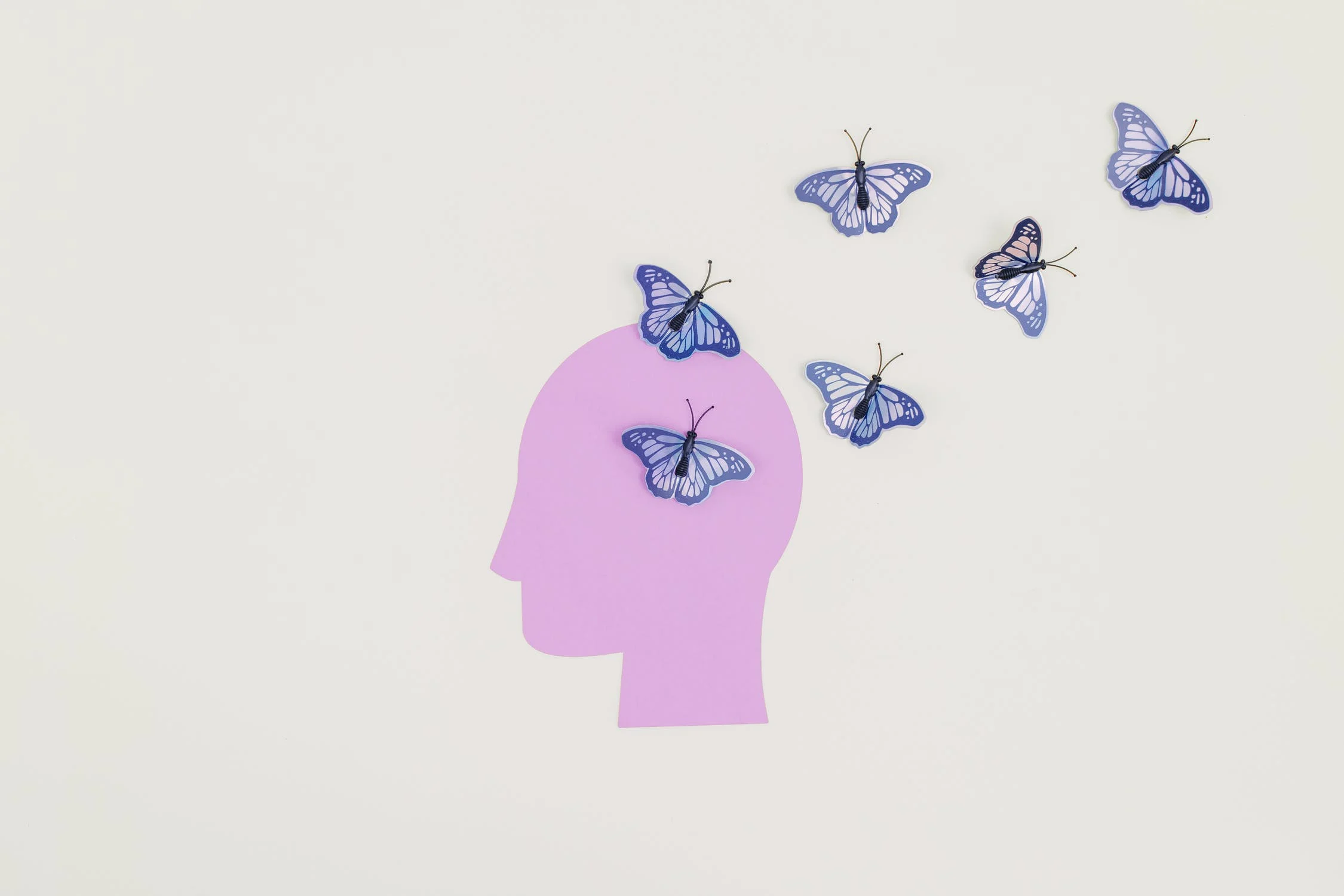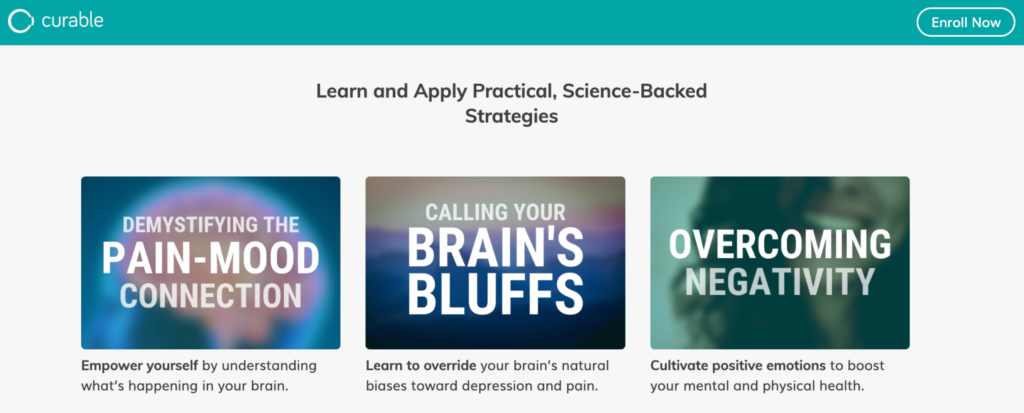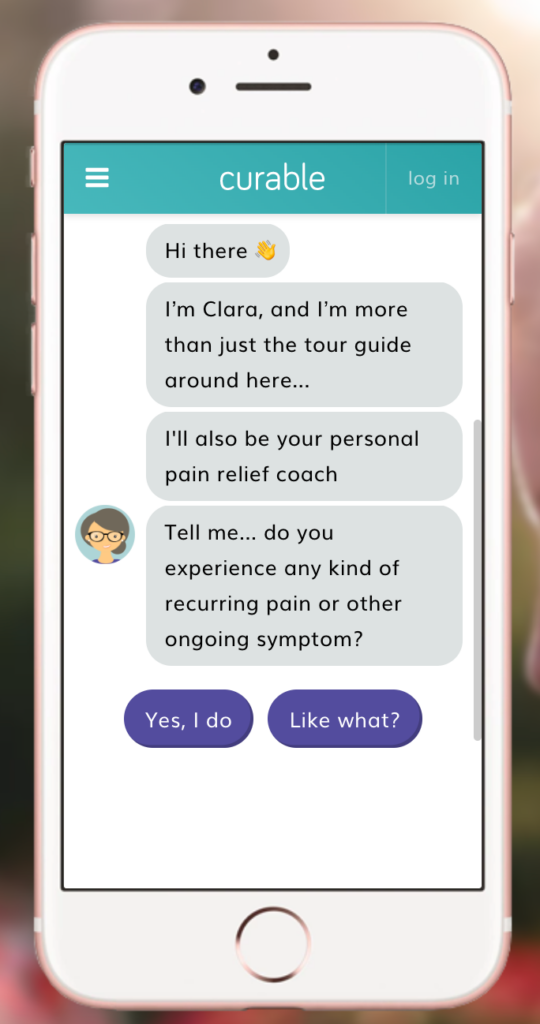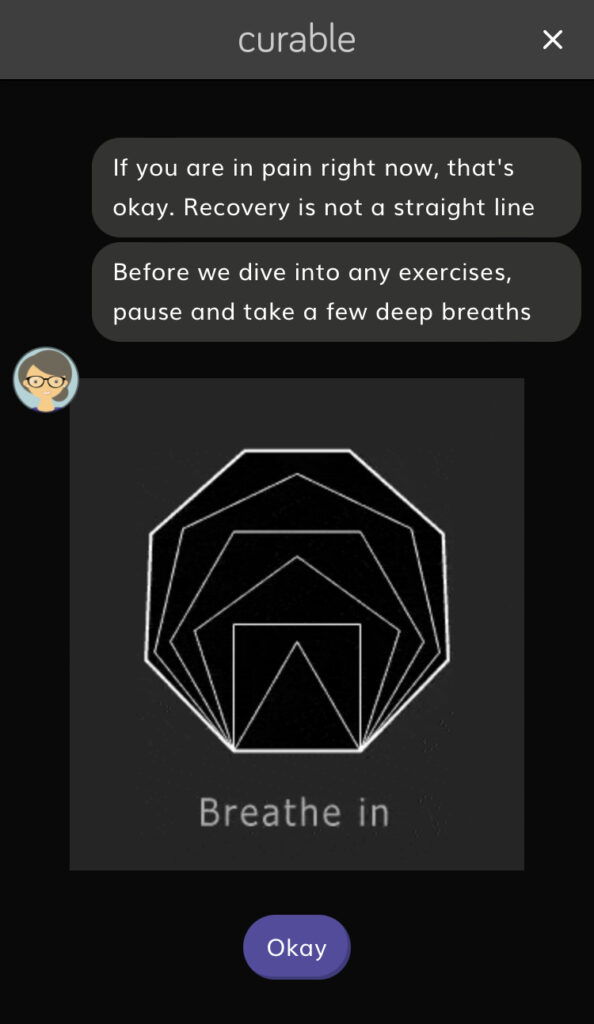
After years of chronic pain and fatigue, Curable changed my life
I have experienced chronic pain, migraines, and fatigue for over 25 years. And I’m not alone. Many, many people — especially women — face chronic pain-related conditions that defy definitive diagnosis or successful treatment.
We go undiagnosed or uncured for myriad reasons, from shortcomings and biases in the health care system to lack of money or insurance, to simply being told our symptoms are “all in our heads.” We also stop seeking help because we blame ourselves. I have lived with my symptoms — including vertigo, disabling neck, back and foot pain, tinnitus, migraine, and exhaustion for years. I have often assumed my lack of a definitive diagnosis meant I was at fault for my suffering because I have not attained perfect eating and exercise habits.
As any other chronic sufferers know, pain and fatigue can cause panic and upend your life. With every new bout, I was terrified of what I wouldn’t be able to get done. Angry that it was all happening again. And scared of what awful undiagnosed thing must be wrong with me. Perhaps worst of all, I would immediately assume the people closest to me must resent me for my weakness, so I’d double down on my efforts to do all my normal tasks to avoid their resentment. This, in turn, deprived me of healing rest and fostered my rage that my loved ones couldn’t help or ever understand how miserable I was.
But last year, I finally found some real relief for my unresolved symptoms from an online program and app called Curable, along with the mind-body science and resources it draws on. Here’s what worked — and didn’t work — for me.

How I found Curable, an online pain psychology program
In late 2021, I experienced an awful increase in my pain and fatigue, including a diagnosis of frozen shoulder. I’m talking so much pain and tiredness, I literally couldn’t think straight or work for more than an hour at a time. When my symptoms first surfaced in 1995, I tried everything imaginable without answers. Eventually I grew reluctant to try more doctors or bodywork. But I was now at a tipping point. I needed serious help.
So, I saw my doctor. She was stumped, though, and left me to do my own research about what specialists or follow-up tests might be helpful. That pissed me the fuck off and made me want to curl up into a ball of hopelessness. Thank goodness my husband prodded me out of my fetal position and suggested I call a friend. She had been diagnosed with fibromyalgia when she lived near us, so maybe she could point me to a better local doctor. But she didn’t. Instead, she excitedly told me her symptoms were 90% relieved thanks to using Curable, an “online program and app designed to help people with persistent pain reduce their symptoms and calm their nervous system,” as the company’s website describes. She strongly encouraged me to try it.
By listening to interviews with the Curable founders, who are all former chronic pain sufferers, and an interview with an extreme migraine sufferer whose life had been totally transformed, I was reassured that Curable might be worth a try. I also confirmed that the app addresses not just many types of chronic pain, but also fatigue and anxiety.
How Curable works
Curable is, at base, an app. But it also includes additional optional resources and group programs. I think of the app as having three sections: the roadmap, the panic button, and the resources section. Guiding you through it all is Clara, a nice little glasses-wearing virtual gal.

Roadmap
In the roadmap, you choose from educational or action-related, such as meditation or “brain training,” options and Clara sets you up with a brief audio session. The idea is twofold: learn more about the current science of pain (more on that below) and retrain your brain to process pain differently.
Panic button
The panic button is for moments of current strong symptoms. Click it and Clara reassures you and gives you some options to help face the moment with less fear or anxiety.
Resources
Finally, the resources include interviews with experts about the mind-body science of pain, recovery stories from Curable users, and Q&As with therapists about mental and emotional aspects of pain.
Online workshops and facilitated support groups
Distinct from the basic app, there are also several optional programs ranging from two to 12 weeks that offer additional materials, videos, and group video meetings for an additional fee. At my friend’s urging, I enrolled in the 12-week Curable Groups program. This involves a series of weekly video workshops lasting one to two hours, followed by weekly group Zoom sessions with an experienced facilitator and group of 10 to 12 other Curable users. Topics range from mental and social habits associated with chronic, undiagnosed health problems (like perfectionism and people pleasing) to deep dives into more effective ways to work with symptoms. The 12 sessions included two group sessions with doctors who answered our questions about chronic symptoms from a medical perspective.
All of Curable is rooted in growing evidence of the mind-body nature of pain. That means Curable’s foundations are far from “woo-woo,” in case, like me, you’re woo-woo suspicious. (Also, a shout-out to the woo-woo folks who intuitively already had a lot of this figured out.)

The mind and body science of pain
We now know, first, that pain is ultimately interpreted and experienced in the brain, not the body. For example, think about how phantom limb syndrome can result in real pain. And, conversely, medication can take away pain even when you are, in fact, physically injured. Second, neuroplasticity allows us to change our experience of pain by consciously changing our neural pathways. When it comes to chronic, unexplained pain or fatigue — such as fibromyalgia or myalgic encephalomyelitis/chronic fatigue syndrome (ME/CFS) — researchers now theorize that many symptoms do not originate in a structural or physically treatable element of the body. Rather, such symptoms may be better explained by aspects of a sufferer’s brain and nervous system, which are molded by their background experiences, personality characteristics, and mental habits.
The late Dr. John Sarno, a stalwart in the field of mind and body research, realized that his patients with chronic back pain often shared traits, such as childhood trauma, major life events that immediately preceded the start of their pain, or a sort of anxious perfectionism that I learned in Curable to call “hypervigilance.” These traits are considered to be evidence that a patient’s brain has learned to use pain signals to protect them from difficult or dangerous situations, behaviors or emotions. The key to relief, therefore, is to convince the brain to unlearn this habit. So, Sarno asked his patients with chronic pain to attend informational sessions about the brain’s role in the experience of pain, instead of having surgery. He discovered that simply understanding the basic mind-body science of chronic pain can be enough for some people to get rid of pain almost immediately. Other people benefit from additional strategies, such as questioning perfectionist or foreboding thoughts, using meditation or breathwork to get out of their heads, or spewing long-held painful emotions onto journal pages.
Indeed, chronic sufferers can try what resonates with them using a variety of resources from the psychological (see: Nichole Sachs’ free podcast and YouTube series) to the spiritual (Tara Brach’s book Radical Acceptance is accessible, no matter what your spiritual or religious inclinations are). I also recommend the recent book The Way Out by Alan Gordon, director of the Pain Psychology Center, which discusses both the science of, and various approaches to relieving, mind-body pain. Curable is rooted in these varied approaches, all of which are represented in the app.
The pros and cons of Curable
Pros:
- Transparent and rooted in science: Good if, like me, you are hesitant to invest in anything that can’t be externally verified.
- Accessible and affordable for many: Everything is done online or via the app. And it’s affordable for many people — and enormously less expensive than many other alternative treatments. The app currently costs $4.99 per month. The cost is an HSA/FSA eligible purchase, and it includes a 30-day, money-back guarantee. Additional programs start at $99 (for two- to six-week, self-guided video workshops) and go up to the nearly $1,200 I laid out for Curable Groups (for 12 weeks of video workshops and small group Zoom meetings, including two meetings with doctors). This was more than worth it to me given how much my symptoms were affecting my entire life, and way less than all the alternative treatments — from Rolfing to cranial-sacral therapy to something that involved putting wheatgrass on my spine?? — that my parents paid for when I was sick and broke in my 20s.
- Flexible: There is no wrong way to use the app. You can lean toward bite-sized lessons on brain science, supportive meditations, listening to podcasts, journaling exercises, or advice on how to reintroduce activities that previously caused you pain. It all works, and nothing is regimented.
- No restrictive diets or required exercise: This is not like elimination or purity programs that promise health if you can follow an inhuman plan (that, in turn, make you feel like your personal failures are the cause of your symptoms).
- Practice to develop habits: Curable isn’t like reading a self-help book you found life-changing at one time, but that later faded from memory and left you where you started. The whole point of the app is to be a constant companion. If your symptoms persist or recur, those symptoms can serve as a reminder to pick up the app.
- Community: Being around others with similar goals is arguably the biggest pro of Curable. Most of us with chronic symptoms have experienced the central loneliness of feeling things that those close to us can’t fully understand. The isolation actually makes the symptoms, and certainly our mental states, worse. Yet, typical support groups for symptoms can also make things worse because, if they lack ground rules and a shared language for positive change, they can encourage wallowing. After the Groups program ended, several members of my group, which I now affectionately call the “Pain Club,” started up a Slack space for daily support and we still meet on Zoom. But even with just the app, the conversational nature of Clara, the virtual helper, and the understanding voices of the presenters — particularly in the content in the panic section of the app — really made me feel less alone.
- Ongoing support: Curable regularly adds new content and resources. Former Groups members also get free access to the app, all the Groups content, future Groups sessions, and little bonus guides to help keep you on your path once your group program has ended.
Cons:
- Cost: $4.99 per month for the app isn’t accessible for some of us, especially given that you have to agree to an annual subscription. The cost of the workshops and group programs are certainly out of reach for many. Although Curable used to have scholarships to cover the cost of group programs, the website no longer publicizes this assistance.
- Time and space: I was lucky enough to be living in a global pandemic with time on my hands when I participated in the group program. Otherwise, the four-hour per week time commitment, during which you need internet and privacy, can be daunting. The app is easier to digest in small bits, but you still need to be ready to commit to taking actions like brief meditations, educational sessions, or journaling. It’s certainly not as simple as taking a pill would be.
- Shifting mindsets is hard: The idea that your own mental habits or personality traits can lead to pain can be extremely hard to swallow if you have any history of fearing your pain is your fault. Curable works hard to flip this script, reminding you that your pain is absolutely real — neurologically as real as if you’d just broken your leg. It’s not your fault and in fact can be the sign of a healthy brain protecting or distracting you from trauma, emotions, and dangerous situations. But it can take a while to find the difference between blaming yourself and empowering yourself.
- Can’t fix our shitty medical system: And here’s the rub. What if your symptoms aren’t caused by mind-body issues, but simply haven’t been diagnosed? This could be because your condition is rare or you’ve been ignored or discriminated against by our medical system — a real danger for so many of us. For what it’s worth, Curable does encourage you to get relevant tests and find a better doctor, if needed. The Curable Groups sessions with doctors are particularly helpful along these lines; one doctor even suggested an exact test I could ask my doctor to order, after apologizing to me for the current state of our medical system and the symptom-enhancing trauma it imposes on so many people.
How I feel today after using Curable
Today I’m still on an unfinished journey. But it’s a very different one from before. I no longer feel the need to take pain medication for my recovering shoulder. Better yet, although I focused my Curable energies on my shoulder and fatigue, I went from daily migraines (or daily migraine medication) to weekly or monthly migraines with even less medication. It’s nice just to type that, to remind myself how far I’ve come.
I still have bouts of migraine, fatigue, and aches, but they’re less disabling and I react to them very differently. This, I think, is the biggest gift of the mind-body approach. It was hard to unravel all my previous panic and emotional stories about how no one in my life could help me. But merely recognizing these reactions upended what I’ve now realized were the worst aspects of my symptomatic episodes: the anger, the fear, the isolation. These are all aspects I have the power to address even when I can’t stop the pain, and they’re greatly relieved by the community I’ve gained. When I’m in touch with my Pain Club, my symptoms hardly seem to matter because I am so steeped in empathy and connection.
In other words, even if my symptoms hadn’t changed at all, my life still would have. I have a different sense of self-knowledge, agency, and hard-won wisdom. And I’ve identified that the worst symptom was my fear that the onset of pain or fatigue would deprive me of the connection and acceptance I so deeply need. Despite still having some symptoms, I am so much less traumatized by them. And I’m not alone.
Photo illustration by Tara Winfield
Keep reading for more insights on caring for your health and wellness in your 40s.
Do you experience chronic pain? What’s worked and hasn’t worked for you? Share your insights in comments below.
Sorry, the comment form is closed at this time.




Adam Werth
Hi Caty,
Lawyer here in the UK/France, with years of CFS/ME, anxiety and now tinnitus. Not currently working. I, too, am using Curable and and reading John Sarno and currently, Steve Ozanich.
Your insights on connection and acceptance also seem to ring true.
I’d love to know how you are doing, how the tinnitus and fatigue are and speak a bit if interested.
adam_werth@hotmail.com.
Best wishes,
Adam